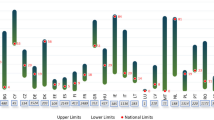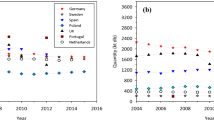Abstract
Sweden has recently introduced new guidelines for the agricultural use of sewage sludge which contain successively more restrictive metal loading rates for soils. At the same time further efforts are made to reduce the input of heavy metals through atmospheric deposition and fertiliser use. The proposed metal loading limits are among the most restrictive in the world, although other scandinavian countries and the Netherlands have proposed similarly low limits. It is the aim of the Swedish Environmental Protection Board to successively reduce the metal load of soils until a situation of zero accumulation is reached. With the possible exception for Cd, there is apparently no scientific evidence at the moment to suggest that zero accumulation of metals in soil is required to adequately protect soil productivity, the environment, and human and animal health. A policy which steers towards zero accumulation may therefore seem excessively cautious. It is, however, also a policy which recognises the practically irreversible nature of elevated heavy metal concentrations and their effects in soil, the deficiencies in the evidence currently available with which to establish safe metal loadings for soils, as well as the need to preserve the agronomic value of soils for many years to come. It is argued that the use of restrictive annual metal loading rates can be used to effectively ensure that maximum soil concentrations or cumulative pollutant loadings, considered to be safe are not reached in the foreseeable future.
Similar content being viewed by others
References
Andersson A (1977) Heavy metals in Swedish soils: On their retention, distribution and amounts. Swedish J Agric Sci 7: 7–20.
Andersson A (1992) Trace elements in agricultural soils - fluxes, balances and background values. Naturvårdsverket Rapport 4077. Statens Naturvårdsverk, Solna.
Andersson A and Bihgeforj S (1985) Trends and annual variations in Cd concentrations in grain of winter wheat. Acta Agric Scand 35: 339–344.
Berglund S (1987) Användning av slam på åkermark.Naturvårdsverket Rapport 3391. Statens Naturvårdsverk, Solna.
Bernes C (1987) Monitor 1987. Heavy metals - occurrence and turnover in the environment. Naturvårdsverket, Solna.
Boström CE, Heikensten ML, Mark-Berglund T, Sandberg E and Slorach S (1993) Miljöstörningar och hälsa.Naturvårdsverket Rapport 4139. Statens Naturvårdsverk, Solna.
Bowen HJM (1977) Residence times of heavy metals in the environment. International Conference on heavy metals in the environment 1: 1–19.
Bowen HJM (1984) Environmental chemistry of the elements. London, Academic Press.
Commission of the European Communities (1986) Council Directive of 12 June 1986 on the protection of the environment, and in particular of the soil, when sewage sludge is used in agriculture. Official Journal of the European Communities L181 (86/278/EEC): 6–12.
Davis RD, Stark JH and Carlton-Smith CH (1983) Cadmium in sludge-treated soil in relation to potential human dietary intake of cadmium. In: Davis RD, Hucker G and L'Hermite P (eds) Environmental effects of organic and inorganic contaminants in sewage sludge, pp 137–146. D. Reidel, Dordrecht.
U.K. Department of Environment (1989) Code of practice for the agricultural use of sewage sludge. Her Majesty's Stationary Office, London.
Eriksson JE (1990) A field study on factors influencing Cd levels in soils and in grain of oats and winter wheat. Water, Air, and Soil Pollut 53: 69–81.
Eriksson JE, Andersson A and Wenblad A (1990) Cd, Ni and Zn contents of oat grain as related to soil factors and precipitation. Swedish J Agric Res 20: 81–87.
Hansen JA and Tjell JC (1983) Sludge application to land - overview of the cadmium problem. In: Davis RD, Hucker G and L'Hermite P (eds) Environmental effects of organic and inorganic contaminants in sewage sludge, pp 91–112. D. Reidel, Dordrecht.
JECFA (1972) Evaluation of certain food additives and the contaminants mercury, lead and cadmium 1972. WHO Technical Report Series 505.
Jones KC, Symon CJ and Johnston AE (1988) Atmospheric inputs of cadmium to an arable agricultural system. In: Mathy P (ed) Air Pollution and Ecosystems, pp 548–553. D.Reidell Publishing Company, Dordrecht.
Jörnstedt O (1992) Mindre kadmium i handelsgödsel. Statens Offentliga Utredningar 1992:14. Jordbruksdepartementet, Stockholm
Juste C and Mench M (1992) Long-term application of sewage sludge and its effect on metal uptake by crops. In: Adriano DC (ed) Biogeochemistry of trace metals, pp 159–194. CRC Press, Inc, Boca Raton.
Larsen KE and Petersen J (1993) Langvarige mark- og lysimeterforsog med årlig tilforsel af store mængder tungmetalholdigt spildevandsslam. Statens Planteavlforsøg, Rapport 3.
MAFF (1993a) Review of the rules for sewage sludge application to agricultural land. Soil fertility aspects of potentially toxic elements. Report of the independent scientific committee. MAFF Publications, London.
MAFF (1993b) Review of the rules for sewage sludge application to agricultural land. Food safety and relevant animal health aspects of potentially toxic elements. MAFF Publications, London.
McGrath SP (1987) Long term studies of metal transfers following application of sewage sludge. In: Coughtrey PJ, Martin MH and Unsworth MH (eds) Pollutant transport and fate in ecosystems. Vol 6, pp 301–317. British Ecological Society, London.
McGrath SP, Chang AC, Page AL and Witter E (1994a) Land application of sewage sludge - Scientific perspectives of heavy metal loading limits in Europe and the United States. Env Reviews 2: 1–11.
McGrath SP, Chaudri AM and Giller KE (1994b) Long-term effect of land application of sewage sludge: Soils, microorganisms, and plants. In: Proceedings of the 15th International Cogress of Soil Science, Mexico (in press).
McGrath SP and Lane PW (1989) An explanation for the apparent losses of metals in a long-term field experiment with sewage sludge. Environ Poll 60: 235–256.
Miljøministeriet (1989) Bekendtgørelse om anvendelse af slam, spildevand og kompost m.v. til jordbrugsformål. Miljøministeriets bekendtgorelse nr. 736 af 26 oktober 1989.
Naturvårdsverket (1987) Hantering av slam från kommunala reningsverk. Naturvårdsverket Allmänna Råd 87:9. Statens Naturvårdsverk, Solna.
Naturvårdsverket (1990) Slam från kommunala avloppsreningsverk. Naturvårdsverket Allmänna Råd 90:13. Statens Naturvårdsverk, Solna.
Naturvårdsverket (1993) Renare slam - Åtgärder för kommunala avloppsreningsverk. Naturvårdsverket Rapport 4251. Statens Naturvårdsverk, Solna.
Notter M (1993) Metallerna och miljön. Naturvårdsverket Rapport 4135. Statens Naturvårdsverk, Solna.
Palm O (1989) Slam - Hantering och miljöproblem. Naturvårdsverket Rapport 3632. Statens Naturvårdsverk, Solna.
Sauerbeck D. R. and Styperek P. (1986) Long-term effects of contaminants. In: Processing and use of organic sludge and liquid agricultural wastes. Proceedings of the 4th International Symposium, Rome (P. L'Hermite, Ed), pp. 318–325. Reidel, Dordrecht.
SNFS (1994) Kungörelse med föreskrifter för miljön, särskild marken, när avloppsslam används i jordbruket. SNFS 1994:2 MS:72. Statens naturvårdsverks författningssamling. Miljöskydd, Stockholm.
Socialstyrelsen (1970) Slam som jordförbättringsmedel. Socialstyrelsen, Stockholm.
Socialstyrelsen (1973) Användning av rötslam som jordförbättringsmedel. Råd och Anvisningar 30. Socialstyrelsen, Stockholm.
U.S. Environmental Protection Agency (1989) Land application and distribution and marketing of sewage sludge. Technical support document. Office of Water and Regulations and Standards. Washington, DC.
U.S. Environmental Protection Agency (1993) Standards for the use and disposal of sewage sludge. Federal Register 58, 9248–9415. Washington, DC
VROM Nederland. Ministerie van Volkshuisvesting Ruimtelijke Ordening en Milieubeheer (1993) Het besluit kwaliteit en gebruik van zuiveringsslib, compost en zwarte grond. Ministerie VROM, Den Haag.
Witter E (1989) Agricultural use of sewage sludge: Controlling metal contamination of soils. Naturvårdsverket Rapport 3620. Statens Naturvårdsverk, Solna.
Author information
Authors and Affiliations
Rights and permissions
About this article
Cite this article
Witter, E. Towards zero accumulation of heavy metals in soils. Fertilizer Research 43, 225–233 (1995). https://doi.org/10.1007/BF00747706
Issue Date:
DOI: https://doi.org/10.1007/BF00747706




